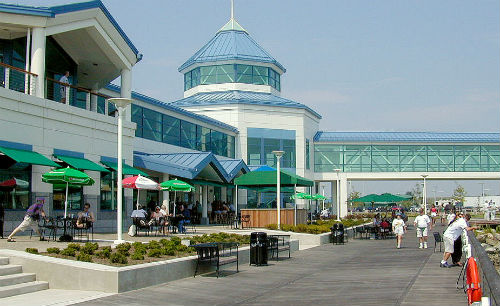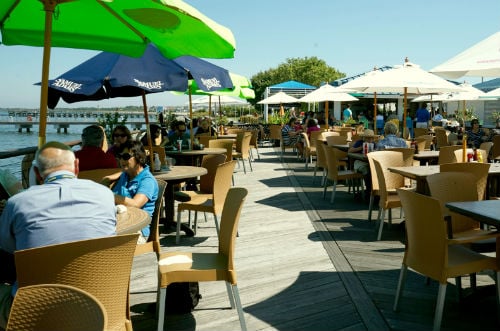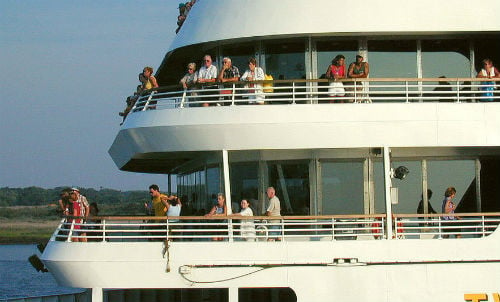For more than 50 years, the Cape May-Lewes Ferry (CMLF) has been a major link between the two shore side destinations of Cape May, NJ and Lewes, DE, providing visitors with unique opportunities to explore the region and all of its outdoor attractions.

The Cape May-Lewes ferry service has terminals in Cape May, NJ and Lewes, DE and offers an 18-mile, 85-minute direct run across the Delaware Bay offering an exciting break from the road. Photo courtesy VisitDelaware.com
Ideal for RVers making their way up and down the Northeast corridor from such areas as New York, Massachusetts, Long Island and North New Jersey, or Florida, the Carolinas, and Virginia from the south, the CMLF has terminals in Cape May, NJ, and Lewes, DE, and offers an 18-mile, 85-minute direct run across the Delaware Bay.
In addition to offering an exciting means of travel, the CMLF is a great way to break up a long trip, take a rest from the road, or explore the two cities for the day. In fact, the link has become more and more popular among RVers over the years and in 2015 alone more than 5,000 RVs registered on the CMLF.

One of the terminals where RVers can access the ferry. Photo courtesy of the DRBA.
“The whole ferry experience is about getting out of your vehicle and enjoying the area,” said Rhona Bronson, Director of Marketing for the Delaware River and Bay Authority (DRBA). “RVers truly enjoy unique travel experiences and the ferry provides that, whether RVers are passing through or staying for any length of time. They can also take day trips to one terminal or the other and check out all the attractions at their convenience. ”
Bronson explained the ferry terminal in New Jersey can be accessed directly from New Jersey’s Garden State Parkway, an RV-friendly, tree-lined passage that leads visitors from the busier centers of Newark or New York, down to the popular Jersey Shore.
If traveling from the Delaware side, the terminal in Lewes also gets RVers off I-95 and can be accessed via Routes 1 and 9, or Routes 13/113 from the Chesapeake Bay Bridge-Tunnel.
Schedule and access in Cape May and Lewes
The fleet of the CMLF consists of three vessels, each with a car deck capacity of 2100 feet, which can accommodate the largest of RVs. Bronson explained there is no RV that is too large to take, yet RVers should realize that there is a height restriction of 13 feet, six inches.

RVers can wait for the ferry enjoying great views of Delaware Bay at the waterfront restaurant – On The Rocks Bar and Grill. Photo courtesy of the DRBA
“The only size I have seen height problems with are 18-wheel tractor-trailers that sometimes need to lower the air in their tires,” says Bronson. “To my knowledge, there is no class of RV that we cannot accommodate and the vessels can even take RVs with towables, for an extra length charge.”
Currently, the CMLF vessels are running full capacity due to high season, and the high volume of visitors. The ferries run approximately every hour from both terminals and there 10 to 12 crossings per day (each way). On slower days or less busy times of the year, there are approximately four to nine crossings each way.
The cost of the ferry service varies from vehicle to vehicle and passenger load. While summer is a great time to take the ferry, boarding in the spring and fall has its merits as well. Plus, there are cost savings. Reservations are always recommended.
Prior to the ferry journey, RVers can abide their time by enjoying great views of Delaware Bay at the waterfront restaurant—On The Rocks Bar and Grill—or browse the gift and souvenir shops featured at both terminals. Live music is also provided with a summer concert series most Wednesdays throughout July and August in Cape May and some Thursdays in Lewes.
When the vessel sets sail, special Friday and Sunday cruises provide live entertainment. On all sailings, indoor and outdoor food concessions are available, and many sites can be enjoyed along the way. For example, Delaware Bay—the second largest bay on the east coast next to The Chesapeake—offers a big water experience with ecological diversity. For example, it’s not uncommon to see whale or dolphin sightings, plus many species of birds.

Visitors can also see a series of attractions along the 85-minute ferry ride. Photo courtesy of the DRBA
“The ferry runs Route 9 over water and also what is known as the 95 highway of the sky,” says Bronson. “In the fall and spring there’s a massive migration of birds that do something called “the bird fall” where birds head south from Canada and literally swoop down from the sky to feed and rest before they make their journey across Delaware Bay.”
According to the Western Hemisphere Shorebird Reserve Network, the bay is a major staging area for 80 percent of the Atlantic flyway population of Snow Geese (and up to 200,000 swarm past the region every year). The area is also an ideal location for nesting sites of bald eagles, ospreys, northern harrier, waders—such as yellow and black crowned night herons—and migrating raptors.
Other popular sightings on Delaware Bay include the historical attractions including The Cape May Lighthouse, the Harbor of Refuge Light, and The Delaware Breakwater Lighthouse, which were all built in the late 1800s. Visitors should also keep an eye for the Lookout Towers in Cape May and Cape Henlopen that were once in operation during World War II to watch for the potential threat of German submarines and PT-boats.
Upon in arriving in Cape May or Lewes, routes for RVers are clearly marked and easily accessible, and several campgrounds are approximately 20 minutes away in both locations. Beaches, boardwalks and attractions of all kinds are also never too far away. Opportunities for outdoor activities, shopping, and dining opportunities abound.
“RVers enjoy non-traditional traveling experiences and ferry travel on the CMLF is one of the interesting ways of enjoying their destination, whether they are staying for a week-long vacation or continuing on,” explained Bronson. “When it comes to RVing, it’s all about the journey and the ferry service is just one of the ways to enjoy that much more.”

My family lived in Lewes during the 1600s. I’ve never been there, but this gives me added incentive.
We recently took the Cape May – Lewes Ferry on our way from Florida to Canada and again for the return trip. The largest benefit to us is that we avoided the traffic from Richmond, Washington, Baltimore, and Philadelphia. Well worth the ferry fees!